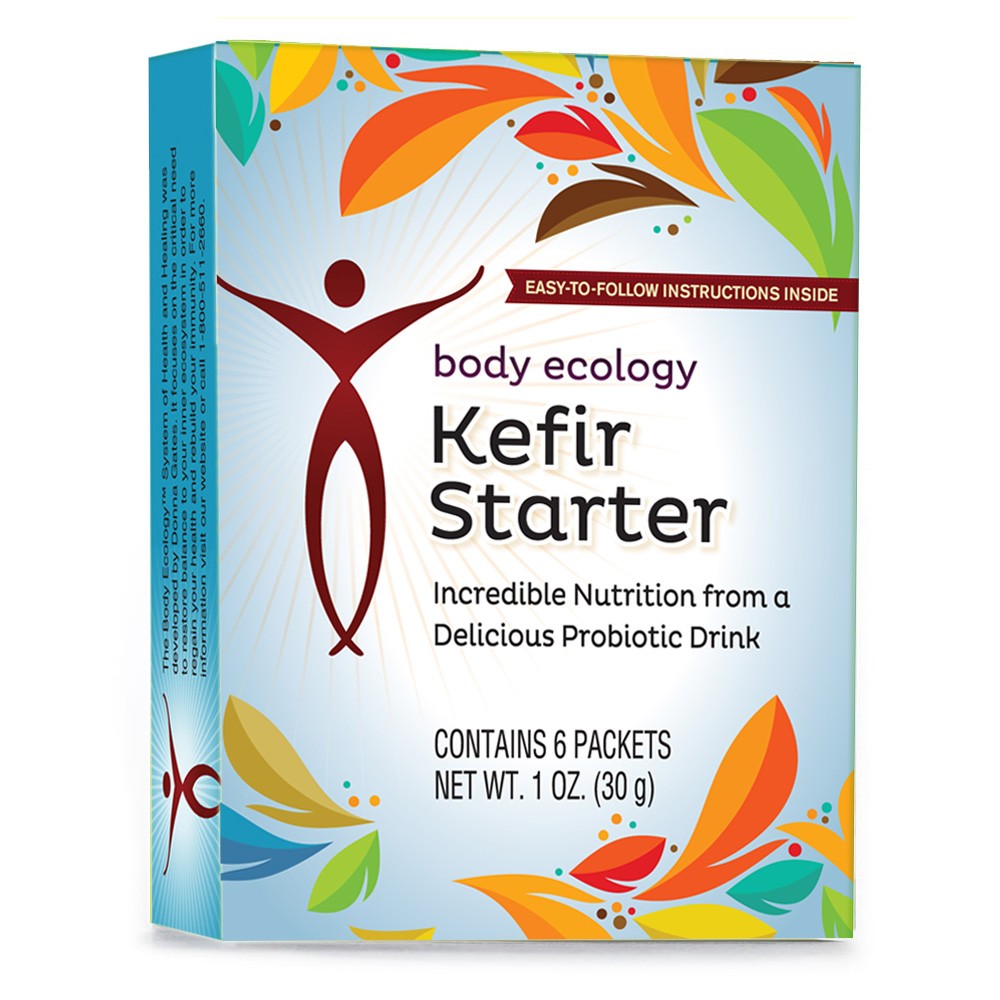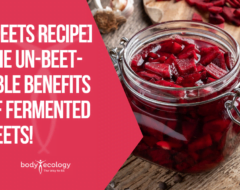Make homemade Cocoyo — What makes kefir better than yogurt [recipes]
Have you gone off dairy? Introducing kefir: the dairy product with the power to make you feel good.
What is kefir?
The good bacteria and yeast in kefir grains predigest the milk proteins, making milk kefir nutrient-dense and easy to assimilate. To receive kefir’s many health benefits, fermenting dairy at home with the Body Ecology Kefir Starter Culture is easy.
Kefir is a traditional fermented dairy food. In Turkish, the name “kefir” is derived from a word that translates into “good feeling.” Kefir is traditionally made with kefir grains, which are not grains at all. The pearly, gummy kefir beads are a mixture of beneficial bacteria and yeast. These beneficial bacteria and yeast feed on milk sugars and grow within the matrix of the dairy.
The first known use of kefir was in Turkey, and the Russians were jealous of this wonderful Turkish food. As the story goes, the Turks wouldn’t share their secret of kefir and how they made it. Back in those days, the Turks told the Russians that this food was given to them by a messenger god, who said not to change it in any way.
You could say kefir was “heaven sent.”
According to an ancient legend, a beautiful woman was sent from Russia to Turkey to seduce the king’s son and learn how kefir was made. Upon meeting her, the prince fell immediately in love. She agreed to marry him but only if he taught her how to make kefir. He refused, so the young woman returned home. Heartbroken the prince ordered his guards to kidnap her and bring her back to him — keeping her a prisoner. This caused a serious conflict between the two countries—tiny little Turkey and powerful Russia. The uproar was finally resolved when the Turkish king was forced to share the grains with Russia.
Today, the Russian culture consumes more kefir than any other country in the world. Poland comes in second. During the warmer months, they drink even larger quantities of kefir is consumed because it’s naturally cooling to the body. In countries where people drink kefir, they know to dilute it with water and not to drink it straight. We recommend doing this too. The casein in dairy seems to be more contracting and can be constipating to some. See if diluting it with water creates a more balanced drink.
Russian children grow-up drinking kefir, and because their microbiome is colonized early in life with beneficial bacteria and yeast, most are able to enjoy milk products throughout their lives. Babies in Russia start drinking kefir at four months old, diluted with water. It’s well known that kefir builds their immune system. The Russian government knows that this nourishing food is so important to young children that it is offered to them when they arrive at school each morning. Milk kitchens supply free kefir to pregnant and nursing women to nourish the mother and her developing child. Many people who are “lactose intolerant” often find that they have no difficulty digesting fermented milk products. That’s because most of the milk sugar (lactose) is consumed during fermentation. Drinking fermented kefir has been proven to reduce or drastically eliminate symptoms of lactose intolerance.1
Best milk for kefir?
If you are drinking milk from a cow, make sure it’s A2 milk, which is usually from the Jersey and Guernsey breeds of cow. The A2 protein (casein) is much easier to digest than A1 protein. Unfortunately, most of the milk and yogurt sold in the US is from A1 cows. Goat, camel, sheep, and even breast milk are also examples of A2 milk. A2 milk has recently become available in most grocery stores around the US.
If you have access to raw milk from healthy grass-fed animals, then make your kefir with raw milk. It’s easier to digest and contains beneficial microbes. Since it’s not heated and it’s in its raw form when the culture starter is added, it retains its natural enzymes and beneficial bacteria, making it a superior food. This is another advantage of kefir over yogurt. Fortunately, raw milk is much more available now around the country. So, you might want to go to the extra trouble and seek out a local farmer who supplies raw dairy.
What is the difference between kefir and yogurt?
What makes kefir unique is that it’s the only fermented dairy product that contains yeast, and yes, you want beneficial yeast in your inner ecosystem. Homemade kefir is teeming with beneficial microbes and is much more alive than store-bought yogurt. Yogurt purchased from the store not only contains fewer microbes, it usually includes a lot of sugar.
Yogurt is always pasteurized and heated to a much higher temperature, then cooled before the bacteria are added. Heat denatures, or changes the structure of milk proteins and makes them more difficult to digest. If you cannot obtain raw milk and must buy pasteurized milk, fermenting helps eliminate some of the damage from the pasteurization.
A visit to any grocery or health food store clearly shows that yogurt is much more popular than kefir. But, if you are one of the many parents who feed yourself or your children store-bought yogurt, try homemade kefir instead. It’s as fun and as easy to make as Kool-Aid. Simply warm 4 cups of your desired milk to skin temperature (about 98 degrees) and add the Body Ecology Kefir Starter. Pour the milk and starter into a quart-sized glass jar and let it ferment for 18 – 24 hours. Chill and enjoy.
Children seem to enjoy it even more when they make it themselves. Try adding blueberries, fresh lemon or lime juice or flavorings like vanilla extract. Keep your kefir sugar-free by adding Stevia or Lakanto® instead.
If you are not one of the lucky ones who can have dairy from cow milk, try goat or camel milk instead. Or, make the kefir using one of the non-dairy milks available today. (Be careful with almond and cashew milk though, because they are extremely high in oxalates. Fermenting however, may reduce the oxalates. But this hasn’t been tested.)
A 2012 study published in the Journal of Dairy Science found that the beneficial bacteria and yeast found in kefir can regulate inflammation in the gut.2 And a 2010 study in the Journal of Food Science noted that these microbes can balance the immune system response meaning they can help control allergies.3
It appears to have heart-protective properties according to a 2016 study published in the Journal of Dairy Science titled, “Investigators reviewed research on a rising fermented foods star: fermented dairy.” Researchers say, kefir may be considered as an alternative to antihypertensive drugs with the potential to lower blood pressure and heart rate. More research is needed, but scientists view kefir’s heart-protective benefits as a “great opportunity.”4
You might also find relief from your chronic gastritis, all made possible by the therapeutic effects of fermented milk.5
You might also see a noticeable improvement in your skin, just by making the switch from commercial yogurt to kefir.6
And it’s possible that your favorite fermented dairy product has the power to fight off cancer.7
2 kefir popsicles recipes
1. Raspberry ginger popsicles
skill level: easy | yield: about 12 servings (yield depends on the size of your popsicle molds) | time: 5 minutes (active), 12 hours (freezing)
Ingredients:
- 2 cups coconut milk
- 6 cups fresh or frozen raspberries
- 1 tbsp grated ginger
- 1 package Body Ecology Kefir Starter Culture
- 1/2 teaspoon Body Ecology Stevia Liquid Concentrate
Method:
- Warm coconut milk to about 90 F. Place raspberries, ginger, coconut milk, and Kefir Starter Culture into a blender. Blend until smooth. Put in a jar with a lid, close the lid, and allow to ferment at room temperature for 8 to 12 hours.
- Transfer the raspberry-ginger kefir to a pitcher. Whisk in Stevia, then pour into popsicle molds, and freeze for at least 24 hours.
2. Coconut kiwi popsicles
skill level: easy | yield: about 1 qt | time: 5 minutes (active), 8 to 12 hours (fermentation), 24 hours (freezer)
Ingredients:
- 2 cups coconut milk
- 4 kiwis, finely chopped
- 1 package Body Ecology Kefir Starter Culture
- 1 scoop Vitality SuperGreen
- 10 drops Body Ecology Stevia Liquid Concentrate
- 1 tsp vanilla
Method:
- Warm coconut milk to about 90 F. Stir in Kefir Starter Culture and kiwis. Put in a jar with a lid, close the lid, and allow to ferment at room temperature for 8 to 12 hours.
- Pour cultured coconut and kiwis into a blender with Vitality SuperGreen, Stevia, and vanilla. Blend until smooth.
- Pour into popsicle molds and freeze at least 24 hours.
REFERENCES:
- “Kefir May Bolster Lactose Tolerance In Intolerant People.” Ohio State University.
- Chen YP, Hsiao PJ, Hong WS, Dai TY, Chen MJ. Lactobacillus kefiranofaciens M1 isolated from milk kefir grains ameliorates experimental colitis in vitro and in vivo. J Dairy Sci. 2012 Jan;95(1):63-74. doi: 10.3168/jds.2011-4696.
- Hong WS, Chen YP, Chen MJ. The antiallergic effect of kefir Lactobacilli. J
Food Sci. 2010 Oct;75(8):H244-53. doi: 10.1111/j.1750-3841.2010.01787.x. Epub
2010 Sep 20. - L.M. Beltrán-Barrientos, A. Hernández-Mendoza, M.J. Torres-Llanez, A.F. González-Córdova, B. Vallejo-Córdoba. Invited review: Fermented milk as antihypertensive functional food. Journal of Dairy Science, 2016; 99 (6): 4099 DOI: 10.3168/jds.2015-10054.
- Rodríguez C, Medici M, Mozzi F, Font de Valdez G. Therapeutic effect of Streptococcus thermophilus CRL 1190-fermented milk on chronic gastritis. World Journal of Gastroenterology, 2010; 16 (13): 1622 DOI: 10.3748/wjg.v16.i13.1622.
- H. Kimoto-Nira, Y. Nagakura, C. Kodama, T. Shimizu, M. Okuta, K. Sasaki, N. Koikawa, K. Sakuraba, C. Suzuki, Y. Suzuki. Effects of ingesting milk fermented by Lactococcus lactis H61 on skin health in young women: A randomized double-blind study. Journal of Dairy Science, 2014; 97 (9): 5898 DOI: 10.3168/jds.2014-7980.
- de Oliveira Leite AM, Miguel MA, Peixoto RS, Rosado AS, Silva JT, Paschoalin VM. Microbiological, technological and therapeutic properties of kefir: a natural probiotic beverage. Braz J Microbiol. 2013 Oct 30;44(2):341-9. doi: 10.1590/S1517-83822013000200001. eCollection 2013.










